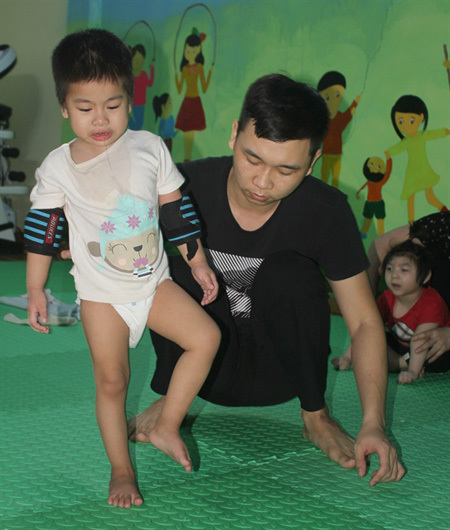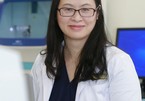 |
| A doctor helps a cerebral palsy child with rehabilitation. — VNA/VNS Photo Thuy Dung |
The cerebral palsy rehabilitation centre was established two years ago by Ninh Binh Province’s Association of Cerebral Palsy Children. It is called ‘Green House’ by the founders, carrying hope of a better future for the children.
Nguyen Thi Lua, president of the association, said having a child with cerebral palsy herself she sympathises with the challenges parents face. She and other parents decided to set up the centre hoping to give families of children with cerebral palsy a place to share their experiences and difficulties as well as offer support for one another.
The association’s members have increased from 60 in the early days to 80 now, all of whom are families with cerebral palsy children.
At first most of the families were from Ninh Binh Province, but then they started to welcome more people from neighbouring areas.
Tran Thuy Vinh from Hoa Lu District donated two rooms in her house to be used as rehabilitation rooms for the children. She also offers free food, accommodation and covers water and electricity bills for families who want to stay at the centre due to the distance.
The centre now has one eastern medicine doctor and one rehabilitation specialist who offer acupressure therapy combined with rehabilitation for the children.
Nine children regularly stay at the centre while others who live further away have received equipment to use at home.
The centre has donated 60 chairs for the children to practise sitting and standing, as well as other equipment worth more than VND100 million (US$4,350) to 60 children with cerebral palsy in the province thanks to donations from sponsors.
The association has set up groups on social networks to connect parents whose children have cerebral palsy so that they can share treatment knowledge, experiences and support each other.
Nguyen Thi Lua, the association’s president, said that cerebral palsy could not be completely cured, but symptoms and defects could be alleviated with physical therapy. The use of supportive equipment such as benches and standing exercises could also help children a lot in daily activities.
However, many families still considered cerebral palsy children as "patients with no cure", so they did not try to take them for rehabilitation treatment. Some families could not afford the treatment, leading to the risk of disease complications, she said.
Members of the association always tried to find and offer the best treatment in order to help reduce the pain, difficulties and burden on the families and not leave any child behind, she said.
Cerebral palsy is a brain-related condition that affects movement and co-ordination of children before, during or soon after birth.
According to traditional medicine doctor Bui Dong Hai who is offering treatment at the ‘Green House’, the rehabilitation exercises for children with cerebral palsy should start as soon as possible, because they helped avoid the deformation of muscle and joint contraction and allowed children to develop motor skills early.
“They must practise every day. In many cases, the exercises span their whole lives.”
“Most families cannot afford long and expensive treatment for children with cerebral palsy, so it’s difficult to maintain the exercises regularly, affecting the children's recovery.
“Understanding the difficulties of families, my colleagues and I gave up stable jobs at home in Ha Nam Province and headed to Ninh Binh to help parents treat and rehabilitate their children at the lowest possible cost,” he said.
Not only sharing knowledge and experience, Dr Hai and his colleagues also donate their monthly salaries to help children to continue their exercises.
Nguyen Thi Nhung, the mother of a one-year old child, got to know about the rehabilitation centre seven months ago.
“My son was born with cerebral palsy and other illness so he cried all day and night. Due to financial difficulties, I could not take him to other localities for treatment. Then I was introduced to the cerebral palsy rehabilitation centre right here in my hometown,” she said.
My son started rehabilitation at the age of five months old and has made improvements after seven months of treatment.
“He eats and sleeps better and no longer cries as much as before. This is truly a miracle.”
“The doctors are dedicated. The treatment costs VND4.5 million per month, only one third compared to what it would have done if we'd had to travel a long way. Thanks to assistance from the doctors to cover treatment expenses, my son can maintain regular exercises.” VNS

The doctor who tracks down genes that cause deafness in children
With their method of detecting gene mutations which cause hearing impairments, Dr Tran Thi Thanh Huyen and her co-workers are representing Vietnam at the final round of the ASEAN-US Science Prize.